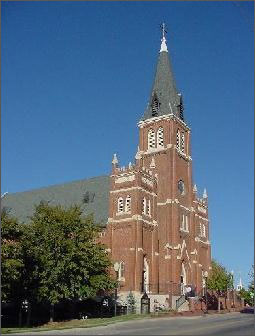
by Krystyna Skvorc, parish historian
In the late afternoon of April 22, 1889, a crowded train carrying hundreds of would-be homesteaders arrived from Purcell. As the frenzied hopeful late-comers jostled their way onto the makeshift platforms, there emerged one tall, solitary figure dressed in black from head to foot. The Rev. Nicolas F. Scallon, attired in the priestly traveling garb of the day, made his way along the dusty trampled paths toward the newly formed Oklahoma City.
Already tents and crude wooden lean-tos had been erected along what was soon called Main Street, Fr. Scallon set about locating each Catholic settler, as well as possible places in which to celebrate Mass. In fact, many of the first Masses were celebrated in a tent which housed McGinley’s General Store. On one occasion after a heavy rain had turned the red dirt of the unpaved streets into a soupy mix of mud and horse manure, Fr. Scallon excused the ladies from attending Mass. He kindly noted that the muck would certainly soil their skirts.
Less than two weeks after The Land Run, Fr. Scallon and his fledgling flock of 16 families began plans to build a church. For $225 they bought three lots on “Blue Hill.” so called because of the srnall blue wildflowers that blanketed that part of the prairie. Work on the 24-x-40-foot wooden structure began July 1, 1889. The cross was placed atop the spire July 31. The $101 bell was hung Aug. 2, 1889.
On Aug. 4, the 650-pound bell for the very first time rang out its joyful call to worship for all to hear. Across the recently settled prairie town, rich and poor, old and young. paused momentarily, and considered each his own journey with God. As the warm summer breeze filtered through the white wooden walls of Oklahoma City’s first Catholic church, the happy tones of the big bell faded.
At once, pioneer priest Fr. Scallon commenced to intone the first Mass in the new building for the recently formed parish of St. Joseph Catholic Church. Who among those families worshiping there that day could have envisioned the stately Coffeyville brick edifice which would, within a few short years, evolve from that simple structure?
In fact, St. Joseph soon outgrew its wood-framed building. On Oct. 19, 1901, excavation begsn for the foundation of a 137-x-64-foot brick building. This new church was solemnly dedicated by Oklahoma’s first Bishop, the Rt. Rev. Theophile Meerschaert on Dec. 18, 1904. Fittingly, lumber and pews from the original St. Joseph were used in the new church. The grand bell found a new home as well from which to proclaim its joyous call to worship. In 1905, Pope Pius X raised the Vicarate of the Oklahoma Territory to a diocese. Thus did St. Joseph Church become the first cathedral in Oklahomal.
Over subsequent decades, the church building, both inside and outside, has undergone several renovations, and has been remodeled numerous times. The most extensive restoration project, however, was necessary by the bombing of the nearby Murrah Federal Building. The old cathedral endured tremendous damage during that megaton explosion. Amazingly, the tabernacle candle remained lit throughout the violent blast. And the beautiful old crucifix with its life-size corpus remained unscratched by the flying glass and debris.

